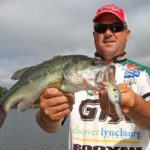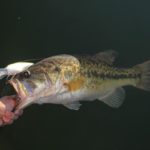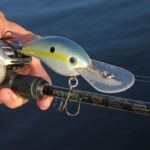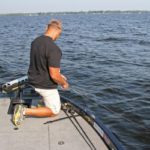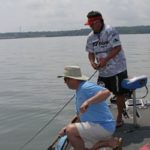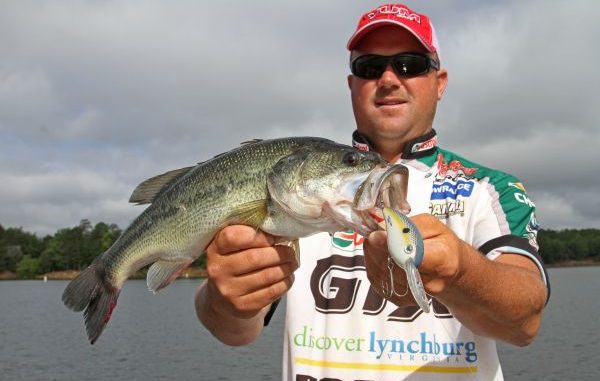
Extreme crankbaits show deep bass —and redfish — attractive profiles that can result in extra bites on hot summer days. But it’s not as easy as just chunking and winding. Here’s how to make these super lures work for you.
They’re big, they’re bad and they’re a handful to sling — those giant crankbaits that have exploded onto the bass-fishing scene over the past couple of years.
Bulky and big-lipped lures made to reach 20-plus feet don’t necessarily offer any great departure from what makes a crankbait a crankbait; it’s just a case of more to love.
More mass, more depth, more big-fish appeal — sounds like an appealing mix.
“The whole idea is just trying to get that bait deeper than a crankbait has ever gone,” said Toledo Bend guide Stephen Johnston. “A lot of those fish in that 19- to 24-foot zone have never seen a crankbait.”
Sure, this isn’t gonna help you much in the Delacroix Marsh or the Red River, but a big crankbait can deliver big results in deeper Louisiana waters like Toledo Bend, those deeper holes in Caddo Lake or Lake D’Arbonne, along with East Texas standout Sam Rayburn and Mississippi’s Ross Barnett Reservoir.
These areas of extreme depth find schools of bass relating to rocks, stumps and contour oddities throughout the suppressing heat of summer, as well as winter’s chill.
Dropshots, football heads and Carolina rigs will nab plenty of these deep fish, but these slower, more methodical presentations are better suited for targeting fish you’ve already located and identified as ready to eat.
For finding deep bass in the food mood — or when you need to fire up a school and pique the interest of the biggest fish — a whopper of a crankbait can be just the ticket.
Missouri cranking expert Marcus Sykora, who recently won the Bass Fishing League’s All-American on Alabama’s Wilson Lake, put it like this.
“Depending on the lake, if the fish and bait are 20-plus feet deep, (deep-diving crankbaits are) a great way to cover the water column effectively and quickly,” Sykora said. “For a search tool, it is hard to beat the efficiency.”
With the road paved by the likes of Mann’s 30+ and the Luhr Jensen Hot Lips, today’s roundup of super-deep crankbaits includes the Strike King 10 XD, Megabass Deep-Six, Spro Little John DD, Livingston Dive Master, Luck “E” Strike RC Series 3 (The Freak), 6th Sense Crush 500, and Jack-It Deep Runner 800.
Impressive in the tackle tray, no doubt, but just getting them wet is no guarantee of turning anyone’s head below the surface.
For optimal performance, consider a handful of pointers.
Line Up
Often targeting the ends of main lake points, Toledo Bend’s Stephen Johnston said line choice greatly impacts bait depth.
Fluorocarbon’s sinking property makes it a must, but he points out the importance of going as light as possible. For him, 12-pound allows his big bait to cut through the water, while providing sufficient strength to handle the kind of fish he hopes to encounter.
Right Rod
“A regular cranking rod isn’t good for those big crankbaits,” Johnston said. “I like a 7-6 medium-heavy rod — something you would use with a Carolina rig. With smaller crankbaits, you want some give in the rod, but it seems like with those bigger crankbaits the bite is more aggressive.
“When that rod loads up and with the weight of the fish, a regular cranking rod isn’t strong enough. I treat a big crankbait basically like a jig — when the fish bites, I lean on them.”
Missouri’s Marcus Sykora goes gorilla with his extreme cranking rod, relying on a Dobyns 806 CB — a heavy, moderate-fast-action stick made for slinging these beefy baits.
“You need a large rod with the right parabolic bend to cast and also catch the deep fish,” Sykora said. “That is a lot of mass, and you need a rod that will absorb a major head shake and still cast it a long ways.
“You also need a powerful reel to handle all the torque as well as power to not wear you out. I recommend a 5.2 gear ratio to transfer the work to your reel and your rod so you can get the bait down.”
Presentation
It’s nothing personal, but crankbaits of any size won’t cooperate without the force applied by properly balanced tackle and the guidance of effective technique.
Bassmaster pro Dave Wolack noted the importance of angles in this scenario. It’s simple geometry: The higher the rod tip, the wider the retrieve angle and the faster the bait starts climbing upward.
So Wolack makes his cast, drops his rod tip for the retrieve and kneels on his bow (“kneeling and reeling”) to minimize that retrieve angle and maximize his crankbait’s time in the target zone.
FLW pro Curt McGuire offered this tip: Make a long cast and use the trolling motor in reverse to maximize the downward force. This often gains another foot or 2 of diving depth.
Sound strategy
Stealth bombers are actually rather large aircraft. The name comes from their ability to sneak in without alerting those they came to, ahem, “visit.”
The same principle can help your extreme cranking game. Sometimes, bold and bawdy gets that piece of plastic killed; other times, a big, noisy bait can spook the fish.
That’s why it’s wise to carry various rattling and muted baits (ex: Strike King’s 10XD and Silent 10XD) so every scenario is covered.
“The only sensitive part to (extreme cranking) is making sure that you don’t scatter the school,” Missouri’s Sykora said. “I’ve seen times that as you retrieve the super-deep divers, you can actually feel the fish on your line get out of the way.
“It is strictly a depth accommodation for me, but as long as you can get by with (extreme crankbaits), it is my thought that the bigger the bait, the better the odds of catching a bigger fish. I love the 6th Sense Crush 500. It has a very subtle, deep knock that allows the fish to locate its presence easily without totally spooking the school.”
Fight the good fight
Sykora said his 8-foot cranking rod not only helps him cast the big lures; it also provides power to set the hook and leverage to keep a big bass buttoned up if it decides to jump a long way from the boat.
Helpful here, he noted, is a key tackle adjustment.
“You really need to upgrade hooks, first and foremost,” Sykora said. “I really like a 1/0 treble, as this is anything from a finesse tactic. Also, with the 15-pound fluorocarbon I use, I don’t hesitate to really apply some torque on the hook sets and crank the bass hard on the way in. Big baits with big trebles really need a solid hook set and hard cranking back to the boat.
“As soon as you realize that the fish is on the way to the surface, really bury the rod in the water and wind as hard as you can. With all that weight (from the lure), those big girls really gain leverage as far as throwing the lure. Power rod, powerful reel and some stout line will really help you gain control.
“This is not for the light hearted — it’s power fishing for deep kickers.”
